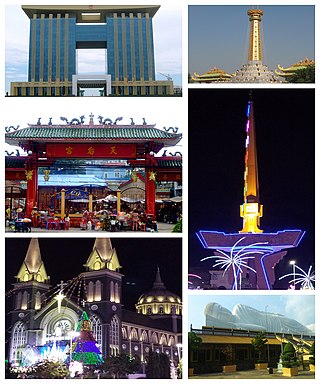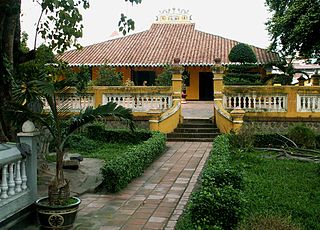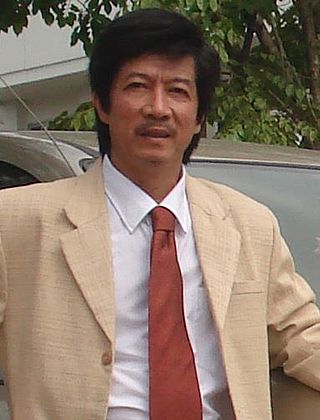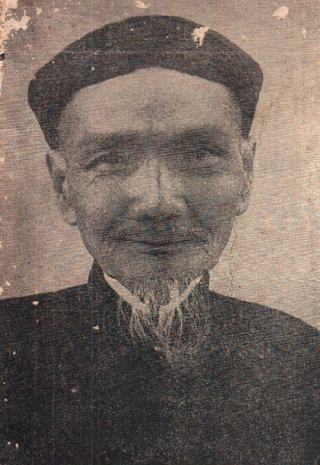Related Research Articles

Thủ Dầu Một is the capital city of Bình Dương province, Vietnam, located at around 10°58′0″N106°39′0″E. The city has an area of 118.66 km², with a population of 417,000, and is located 20 km north of downtown Ho Chi Minh City, on the left bank of the Saigon River, upstream from the city.

Tân Bình is an urban district of Ho Chi Minh City, Vietnam. The city's international airport is situated in the district. It consists of 15 wards, from Ward 1 to Ward 15. It occupies 22.43 km2 (8.66 sq mi). In the 2019 census, Tân Bình district has a population of 474,792 people.

Vương Trung Hiếu is a Vietnamese fiction writer, journalist, translator, and interdisciplinary scholar. He is the author of more than two hundred books. Many of his works are published under the pseudonym Thoai Son.

The Six Provinces of Southern Vietnam is a historical name for the region of Southern Vietnam, which is referred to in French as Basse-Cochinchine. The region was politically defined and established after the inauguration of the Nguyễn dynasty, and called by this name from 1832, when Emperor Minh Mạng introduced administrative reforms, to 1867, which culminated in the eight-year French campaign to conquer the Six Provinces.

Hồ Văn Trung was a Vietnamese writer.
Love Case is a 2008 Vietnamese telefilm adapted from Hồ Văn Trung's July 1941 novel Cư kỉnh (居璟). The film was produced by Ho Chi Minh City Television and directed by Võ Việt Hùng.
Nguyễn Nhữ Soạn, courtesy name Thủ Trung (首中), pseudonym Hiền Đức (賢德), posthumous name Hiền-đức Mister (橫敏先生), was an Annamese official.

The government of the Nguyễn dynasty, officially the Southern dynasty and commonly referred to as the Huế Court, centred around the emperor as the absolute monarch, surrounded by various imperial agencies and ministries which stayed under the emperor's presidency. Following the signing of the Patenôtre Treaty the French took over a lot of control and while the government of the Nguyễn dynasty still nominally ruled the French protectorates of Annam and Tonkin, in reality the French maintained control over these territories and the Nguyễn government became subsidiary to the administration of French Indochina. During World War II the Japanese launched a coup d'état outsting the French and establishing the Empire of Vietnam which was ruled by the Nguyễn government. During the August Revolution the Nguyễn government was abolished in the aftermath of World War II.

Chí Tài or Nguyễn Chí Tài was a Vietnamese comedian, musician, and singer. Initially starting as a composer and singer in the 1990s, he later became famous for his comedy performances alongside his co-star Hoài Linh.

Võ Nguyễn Hoài Linh, better known by his stage name Hoài Linh, is a Vietnamese American comedian and actor. A frequent collaborator of Thúy Nga center, he is known for his comedy performances alongside other artists such as Vân Sơn and Chí Tài.
Here are the channel frequency table analog television broadcast/received in the provinces, the territory in Vietnam, divided by regions across the country. Currently, Analog TV nationwide has stopped broadcasting on 28 December 2020 due to government digitization roadmap. Previously, analog television in Vietnam mostly broadcast on the VHF band, and the UHF band, only a few places broadcast less than 6 VHF, like 3 VHF in Tam Dao).

During the Nguyễn dynasty period (1802–1945) of Vietnamese history its Ministry of Education was reformed a number of times, in its first iteration it was called the Học Bộ, which was established during the reign of the Duy Tân Emperor (1907–1916) and took over a number of functions of the Lễ Bộ, one of the Lục Bộ. The Governor-General of French Indochina wished to introduce more education reforms, the Nguyễn court in Huế sent Cao Xuân Dục and Huỳnh Côn, the Thượng thư of the Hộ Bộ, to French Cochinchina to discuss these reforms with the French authorities. After their return the Học Bộ was established in the year Duy Tân 1 (1907) with Cao Xuân Dục being appointed to be its first Thượng thư (minister). Despite nominally being a Nguyễn dynasty institution, actual control over the ministry fell in the hands of the French Council for the Improvement of Indigenous Education in Annam.
References
- ↑ Anh Quân (July 31, 2016). "Tên gọi Thủ Đức có từ đâu?" [Where did the name Thủ Đức come from?]. Báo Công An.
- ↑ Trung Sơn (October 11, 2020). "Địa danh Thủ Đức có từ khi nào" [When did Thu Duc have its name?]. VnExpress.
- ↑ "Đài Tiếng nói Nhân dân TPHCM và quận Bình Tân luôn đồng hành cùng Nhân dân" [Voice of Ho Chi Minh City's People and Bình Tân District are always with the people]. Voice of Ho Chi Minh City.
- ↑ "GIỚI THIỆU VỀ QUẬN BÌNH TÂN" [Introduction of Bình Tân District]. People's Committee of Bình Tân District's Portal.
- 1 2 "Nghị định số 130/2003/NĐ-CP của Chính phủ : Nghị định thành lập các quận Bình Tân, Tân Phú và các phường trực thuộc; điều chỉnh địa giới hành chính phường thuộc quận Tân Bình; thành lập xã, thị trấn thuộc các huyện Bình Chánh, Cần Giờ và Hóc Môn, thành phố Hồ Chí Minh" [Decree 130/2003/NĐ-CP of the Government: The decree to establish the districts of Bình Tân, Tân Phú and affiliated wards; to adjust the administrative boundaries of wards in Tân Bình District; to establish communes and towns in Bình Chánh, Cần Giờ and Hóc Môn districts, Ho Chi Minh city]. Vietnam Government's Portal.
- ↑ "LỊCH SỬ HÌNH THÀNH HUYỆN BÌNH CHÁNH" [The formation history of Bình Chánh District]. People's Committee of Bình Chánh District's Portal.
- ↑ "Giới thiệu quận Bình Thạnh" [Introduction of Bình Thạnh District]. HCMC Party Committee's Portal.
- ↑ "Quận Bình Thạnh kỷ niệm 40 năm thành lập" [Bình Thạnh District celebrates the 40th anniversary of formation]. Báo Nhân Dân.
- ↑ "Tên quận Gò Vấp (Tp.HCM) là cách đọc trại đi của địa danh gốc nào?" [The name Gò Vấp District is a twisted reading of what original place?]. Hoatieu.vn.
- ↑ "Tiết lộ thú vị về tên gọi quận Gò Vấp" [An interesting revelation of the name of Gò Vấp District]. Báo Tri Thức Cuộc Sống. 23 August 2021.
- ↑ "Đất Phú Nhuận, người Phú Nhuận thuở khẩn hoang" [Phú Nhuận land, Phú Nhuận people in the reclamation era]. Tuổi Trẻ Online. 29 April 2017.
- ↑ "Hướng về Sài Gòn" [Heading to Saigon]. Báo Văn Hóa và Phát Triển.
- ↑ "Giới thiệu tổng quan về quận Tân Phú Thành phố Hồ Chí Minh" [An overview introduction of Tân Phú District, Ho Chi Minh City]. Báo Thanh Niên Việt.
- ↑ "Ngày mới ở Cần Giờ" [A new day in Cần Giờ]. Sài Gòn Giải Phóng Online. 16 March 2015.
- ↑ "Nghĩ về địa danh Bà La và vài địa danh khác theo từ nguyên học" [Thinking about Bà La's name and some other places according to etymology]. Báo Người Đô Thị.
- ↑ "Cây độc: Loài cây 'bị nguyền rủa' trên vùng đất thép Củ Chi, gần trăm năm nhắc tên vẫn sợ hãi" [The poisonous tree: A cursed tree in the steely land of Củ Chi, the name inflicting fear even after nearly one hundred years]. Chất Lượng Việt Nam Online.
- ↑ "Địa danh Củ Chi" [Name of the place Củ Chi]. Sài Gòn Giải Phóng Online. 18 February 2005.
- ↑ "Chuyện xưa chuyện nay: "Hóc Môn" hay "Hốc Môn"?" [Old stories new stories: "Hóc Môn" or "Hốc Môn"?]. Pháp Luật Online. 3 February 2011.
- ↑ Associate Professor, Dr. LE TRUNG HOA. "Từ địa phương chỉ địa hình trong địa danh Nam Bộ" [Local vocabulary of the terrain in the Southern region's names of places]. Faculty of Philology - Hanoi National University of Education.
- ↑ "Giai thoại về Thủ Huồng và câu chuyện về lòng nhân ái" [The anecdote of Thủ Huồng and the story of kindness]. Báo Đồng Nai.
- ↑ "Chuyện Thủ Huồng từ ác hóa thiện" [The change of heart of Thủ Huồng]. Báo Nông Nghiệp. 11 March 2011.
